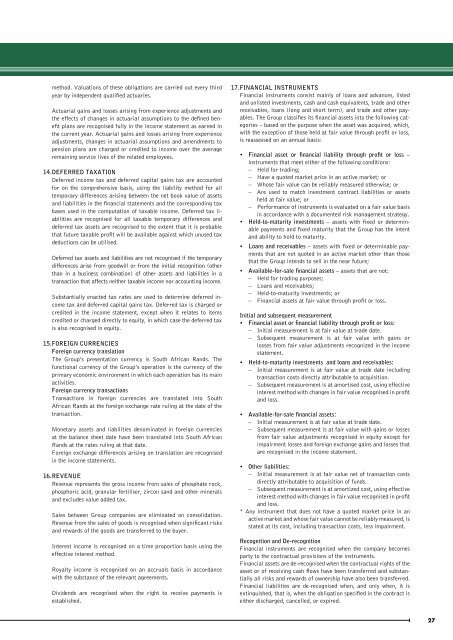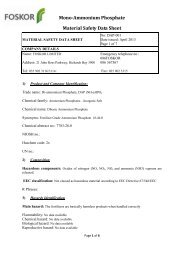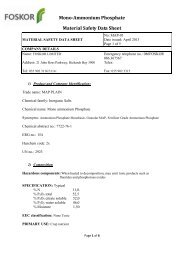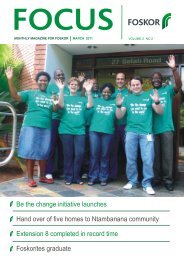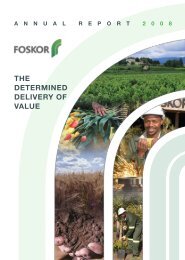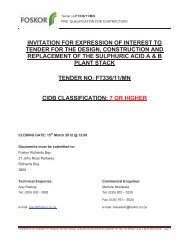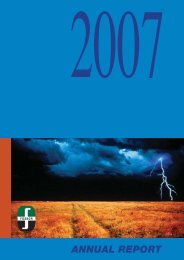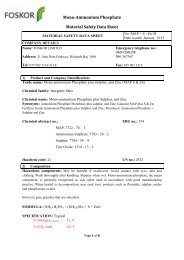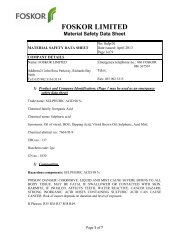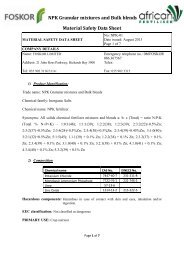Download Annual Report 2006 - Foskor
Download Annual Report 2006 - Foskor
Download Annual Report 2006 - Foskor
Create successful ePaper yourself
Turn your PDF publications into a flip-book with our unique Google optimized e-Paper software.
method. Valuations of these obligations are carried out every thirdyear by independent qualified actuaries.Actuarial gains and losses arising from experience adjustments andthe effects of changes in actuarial assumptions to the defined benefitplans are recognised fully in the income statement as earned inthe current year. Actuarial gains and losses arising from experienceadjustments, changes in actuarial assumptions and amendments topension plans are charged or credited to income over the averageremaining service lives of the related employees.14. DEFERRED TAXATIONDeferred income tax and deferred capital gains tax are accountedfor on the comprehensive basis, using the liability method for alltemporary differences arising between the net book value of assetsand liabilities in the financial statements and the corresponding taxbases used in the computation of taxable income. Deferred tax liabilitiesare recognised for all taxable temporary differences anddeferred tax assets are recognised to the extent that it is probablethat future taxable profit will be available against which unused taxdeductions can be utilised.Deferred tax assets and liabilities are not recognised if the temporarydifferences arise from goodwill or from the initial recognition (otherthan in a business combination) of other assets and liabilities in atransaction that affects neither taxable income nor accounting income.Substantially enacted tax rates are used to determine deferred incometax and deferred capital gains tax. Deferred tax is charged orcredited in the income statement, except when it relates to itemscredited or charged directly to equity, in which case the deferred taxis also recognised in equity.15. FOREIGN CURRENCIESForeign currency translationThe Group’s presentation currency is South African Rands. Thefunctional currency of the Group’s operation is the currency of theprimary economic environment in which each operation has its mainactivities.Foreign currency transactionsTransactions in foreign currencies are translated into SouthAfrican Rands at the foreign exchange rate ruling at the date of thetransaction.Monetary assets and liabilities denominated in foreign currenciesat the balance sheet date have been translated into South AfricanRands at the rates ruling at that date.Foreign exchange differences arising on translation are recognisedin the income statements.16. REVENUERevenue represents the gross income from sales of phosphate rock,phosphoric acid, granular fertiliser, zircon sand and other mineralsand excludes value added tax.Sales between Group companies are eliminated on consolidation.Revenue from the sales of goods is recognised when significant risksand rewards of the goods are transferred to the buyer.Interest income is recognised on a time proportion basis using theeffective interest method.Royalty income is recognised on an accruals basis in accordancewith the substance of the relevant agreements.Dividends are recognised when the right to receive payments isestablished.17. FINANCIAL INSTRUMENTSFinancial instruments consist mainly of loans and advances, listedand unlisted investments, cash and cash equivalents, trade and otherreceivables, loans (long and short term), and trade and other payables.The Group classifies its financial assets into the following categories– based on the purpose when the asset was acquired, which,with the exception of those held at fair value through profit or loss,is reassessed on an annual basis:• Financial asset or financial liability through profit or loss –instruments that meet either of the following conditions:– Held for trading;– Have a quoted market price in an active market; or– Whose fair value can be reliably measured otherwise; or– Are used to match investment contract liabilities or assetsheld at fair value; or– Performance of instruments is evaluated on a fair value basisin accordance with a documented risk management strategy.• Held-to-maturity investments – assets with fixed or determinablepayments and fixed maturity that the Group has the intentand ability to hold to maturity.• Loans and receivables – assets with fixed or determinable paymentsthat are not quoted in an active market other than thosethat the Group intends to sell in the near future;• Available-for-sale financial assets – assets that are not:– Held for trading purposes;– Loans and receivables;– Held-to-maturity investments; or– Financial assets at fair value through profit or loss.Initial and subsequent measurement• Financial asset or financial liability through profit or loss:– Initial measurement is at fair value at trade date.– Subsequent measurement is at fair value with gains orlosses from fair value adjustments recognized in the incomestatement.• Held-to-maturity investments and loans and receivables:– Initial measurement is at fair value at trade date includingtransaction costs directly attributable to acquisition.– Subsequent measurement is at amortised cost, using effectiveinterest method with changes in fair value recognised in profitand loss.• Available-for-sale financial assets:– Initial measurement is at fair value at trade date.– Subsequent measurement is at fair value with gains or lossesfrom fair value adjustments recognised in equity except forimpairment losses and foreign exchange gains and losses thatare recognised in the income statement.• Other liabilities:– Initial measurement is at fair value net of transaction costsdirectly attributable to acquisition of funds.– Subsequent measurement is at amortized cost, using effectiveinterest method with changes in fair value recognised in profitand loss.* Any instrument that does not have a quoted market price in anactive market and whose fair value cannot be reliably measured, isstated at its cost, including transaction costs, less impairment.Recognition and De-recognitionFinancial instruments are recognised when the company becomesparty to the contractual provisions of the instruments.Financial assets are de-recognised when the contractual rights of theasset or of receiving cash flows have been transferred and substantiallyall risks and rewards of ownership have also been transferred.Financial liabilities are de-recognised when, and only when, it isextinguished, that is, when the obligation specified in the contract iseither discharged, cancelled, or expired.27


